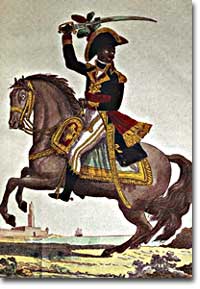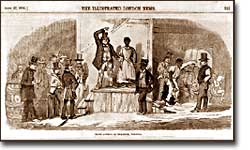20f. Gabriel's Rebellion: Another View of Virginia in 1800
"We hold these truths to be self-evident, that all men are created equal, that they are endowed by their Creator with certain inalienable Rights, that among these are Life, Liberty..."
The activities of a literate slave named Gabriel in Richmond, Virginia, present a final critical view of Jeffersonian America. At the same time Gabriel also shows how fully African Americans embraced central currents of American politics and culture. Gabriel remains a difficult figure to fully reconstruct from surviving historical evidence. In fact, his last name is not definitively known, though he is usually referred to as Gabriel Prosser, after the name of the man who owned him.
Gabriel was a skilled artisan with several advantages over most field-working slaves of his day. Partly due to his skill as a blacksmith, Gabriel was "hired out" to work in many different places and enjoyed more autonomy and mobility than most plantation slaves. As an artisan, Gabriel was among the broad group of urban workers whose actions played a crucial role causing the American Revolution. As an occupational group, they were among the Revolution's biggest winners.
However, as an African American and a slave the benefits of the Revolution were not extended to Gabriel. Nevertheless, the republican ideology of the Revolution and the anti-elitist thrust of the Democratic-Republicans helped shape Gabriel's vision in leading a slave revolt.

Toussaint L'Ouverture followed in the footsteps of the French in abolishing slavery when he became leader of the Haitian Revolution in 1792.
The organizational requirements of a conspiracy to overthrow slavery necessarily shrouded the movement in secrecy. Apparently, however, Gabriel, and a small group of artisan leaders, expected about 1,000 slaves to follow them in a well-coordinated attack upon Richmond that targeted Federalists and merchants who were the most prominent residents of the city.
Gabriel expected "the poor white people" as well as "the most redoubtable republicans" to join his cause to create a more democratic republic in Virginia . He especially identified Quakers, Methodists, and Frenchmen as those whites who were most "friendly to liberty." The purpose of the rebels was clearly expressed in a banner under which they planned to march, which eloquently stated "Death or Liberty." The assault planned for August 30, 1800, however, never came together. Torrential rain caused confusion and a traitor from within the group warned white authorities of the impending attack.
Gabriel's careful planning demonstrates that some enslaved people actively resisted slavery and were well informed about the world beyond their own harsh circumstances. Given the heightened political violence of the 1790s, Gabriel believed that he could forge an alliance with some Democratic-Republicans against a common Federalist enemy. The timing of the revolt, just before the 1800 election, makes it a radical expression of anti-Federalism. Gabriel also secretly met with two Frenchmen who seemed to have promised him international assistance. Gabriel was well aware that the French Revolution had helped trigger the great slave revolt in Haiti in 1791. Perhaps the charismatic and talented Gabriel could have become a successful black political leader like Toussaint L'Ouverture.

An image of a slave auction in Richmond, Virginia, from an 1856 edition of The Illustrated London News.
Instead, Gabriel's slave conspiracy ended in severe repression. While no whites were killed in the revolt that never really got started, the state of Virginia executed 27 blacks, including Gabriel, by public hanging. Whites responded to the planned revolt, and another one linked to it in 1802, by tightening legal restrictions on slaves. For a brief period in the late 18th century white Virginians had modified certain elements of slavery.
Now many whites began to think that making the system slightly more humane had encouraged black resistance. As a result some of the advantages that slaves like Gabriel possessed were made illegal. For instance, literacy and allowing slaves to "hire out" for work in varied settings became illegal. Similarly, the Virginia legislature attempted to prevent enslaved people from piloting boats, a position from which they could travel too freely and learn about changes in the outside world that threatened white masters.
This newly repressive slave system was a tragic outcome for African-American collective action that had intended to liberate slaves. The reinvigorated slave societies of the south thrived in the 19th century and only ended with the massive violence of the Civil War. Nevertheless, the hypocrisy of slavery in a new nation dedicated to democracy was more obvious than ever before in American history. Though the brutal slave regime would continue to try and dehumanize the people it enslaved, it never fully succeeded.
As one member of Gabriel's Rebellion explained during the trial that would ultimately sentence him to death, "I have nothing more to offer than what General Washington would have had to offer, had he been taken by the British and put to trial by them. I have adventured my life in endeavoring to obtain the liberty of my countrymen, and am a willing sacrifice in their cause."






